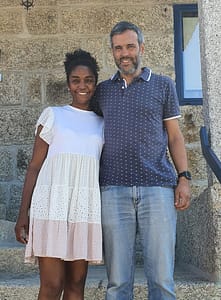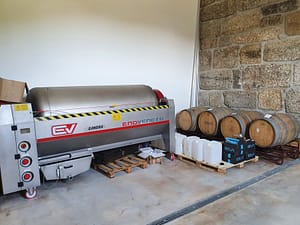After the Simplesmente… Vinho fair I took the opportunity to get an update on the nearby Vinho Verde region. I visited five producers in a program set up by festival general João Roseira and the growers. Here is a report from the three first wineries. These are found in the subregions Sousa and Amarante, only 40 and 60 kilometers respectively, from the city of Porto.
Sem Igual (meaning something like unequalled, or unique) may be a new brand, and it was only in 2012 that João Camizão and his wife Leila Rocha made their first vintage. But João’s family has been grapegrowers in the Sousa and Amarante sub-regions of Vinho Verde since the 18th century. I visited together with an American importer. And from the fair in Porto they drove us in their car to Meinedo, in the municipality of Lousada. Meanwhile they told us the fascinating story about their international background and how they came back. João has for long long worked in telecommunications, and combined for a few years his employment in Nokia with a life as a farmer. It was only in 2016 that he decided to dedicate himself fully to wine, and the family took the chance to move to the village of his childhood.
Their office, storage cellar and guesthouse are located in Meinedo. Here in the Sousa area they have about 10 hectares of vineyards on granite soil with gravel. The vines have an age of up to 70 years, the oldest ones trained in the traditional ramadas.
They are a modern couple, with their international stories, and a busy life with three kids. But watching their vineyards and walking through their cellar it shows clearly that they also feel connected to history. Just look at all the stone and the wooden architecture in their premises, the concrete tanks and the lagares where the grapes are trodden by foot.
We tasted through their range of wines. Sem Igual makes first and foremost white wines, but also sparkling wines, rosés and light reds. Their whites are blends of the two local grapes arinto and azal. In general they are good bodied, non-carbonic, dry wines with a fresh acidity.
The Sem Igual (blue label) is made from 70% arinto and 30% azal, always with whole bunches and very soft pressing. It has virtually no contact with lees. The wine was served in five vintages between 2015 and 2019, to give an impression. All had splendid citrus fruit (lemon peel) with good body, a crisp acidity and no bubbles (sounds maybe strange, but this is opposed to a long tradition of gasification in the region), and a mineral aftertaste – in an overall elegant style. The 2019 and 2017 were for me a bit ahead of the rest, a bit more expressive and with a slight buttery feel. João says that in 2016 they cut down on SO2. This can explain that the latest wines, especially 2019 and 2017 were somewhat darker.
Next was a pair of Sem Igual Ramadas 2018. Dubbed Metal and Wood respectively this denotes that the latter had been in oak, the former not. The Metal came from 50 year old vines, the Wood more than 60, both trained in pergola (ramadas). 60% arinto, the rest azal, the Wood was a bit more buttery, full and with more rounded acidity.
Sem Mal may play with the expression “not bad”, I think, but also with the fact that it had not completed malolactic fermentation (“malo”) before it was bottled. Which makes it a sparkling wine. The 2019 was a fresh one, with small bubbles, citrussy acidity, yellow apples and some yeast. We also tasted the Bruto Natural, a fresh sparkler after 40 months on sediments. Among the rest of the wines we tasted the Pét Nat 2019 was truly fascinating. A half and half touriga nacinal and baga wine, this was their first pét nat and also their first experience with red grapes. Pale salmon-pink; peach and apples; smooth and off-dry, this is easy to drink on a hot summer’s day – and a story to be continued.
Quinta da Palmirinha
Quinta da Palmirinha and Fernando Paiva I have written about several times. Here is a short report following a visit three years ago.
Palmirinha is the family farm, barely 3 hectares located in Lixa, sub-region of Amarante. Fernando has a moderate and polite appearance, but is an undisputed authority in organic and biodynamic farming. A retired history professor, he will consult younger local talent about organic farming, without any pay. As he says while we walk up and down his quite steep vineyard, “if I give away my shirt I don’t have it any more, but knowledge is a thing you can share without losing it yourself.”
His vineyard is a total of almost 3 hectares with mostly 28 year old vines. Loureiro accounts for 2 hectares, the rest azal and arinto. All this is trained in simple cordon.
On his own initiative he has experimented with the use of chestnut flowers that covers the must, so that he can avoid using SO2. Time will show if this will be a revolutionary discovery for the whole sector. Anyway, Fernando has already shared his ideas with several producers.
Outside the adega we also said hello to the chickens that are fertilizing his vineyards. The plant life he calls “spontaneous”. It is like it is, there is no need to adjust. But we see aromatic plants that attracts insects.
He was the first certified biodynamic producer in Portugal. This time he showed me his biodynamic toolcase, with preparations.
The grapes are harvested manually in the morning, gently pressed and the fermentation is spontaneous. The wine stays in stainless steel for 10 months, with batonage twice.
I have tasted his wines many times, in the winery and at fairs. In general they are citric, appley and flowery, mineral, always with a firm structure, but with an integrated acidity. The three wines I tasted this time were all from the 2021 vintage. The Loureiro had more yellow apples, and overall a lovely calmness and harmony, just like the vineyard and the man. The Azal was more to the green apple side, some anise, with a crisper acidity. The Curtimenta (orange wine) called Leviano (tank sample), had 75% loureiro, the rest azal, and 3 weeks skin-contact. The colour is yellow, and smells of clementine peel, ginger and flowers; full in the mouth with some structure. This is an absolutely outstanding trio of wines!
Quinta de Lourosa
José Maia meets me at Quinta de Lourosa, in Sousela (Sousa valley). He has a varied background, and he is still working as a tour guide. The last few years he has been engaged at the winery, to do a little bit of everything. His experience in tourism is well at hand as they have a guesthouse with restaurant and provide guided tours. Their packages include regional gastronomy, handicrafts and day trips to sites of historical and cultural heritage, such as the area’s Romanesque route.
Joanna de Castro is winemaker on the quinta, that now covers 27 hectares. She lives in Lisboa and couldn’t be present that day. But her father was there. Rogério de Castro is a legendary figure, retired oenology professor and acknowledged for having introduced the training system that has come to be called Lys. The idea behind it is to enable a better sun exposure. Now the professor is passionately working the vineyards at Quinta de Lourosa. He has also in the latest decades renewed the 17th century chapel and the eaves on the farm. As we were walking around the estate he showed me different examples of the Lys system. It’s maybe more a concept than a technique. The idea is to distribute the plants to give ventilation. Very commonly first the plant grows to the left and to the right, then it moves upwards. With this system the plant also grows much stronger.
José tells me that the estate doesn’t produce organic wines as such. But they do care about the landscape and soil. -We use chemicals only when we have to, he says. -And the future is not to use. They are in fact planting peppermint between the rows to attract insects, only to mention one feature.
The wines were in general fresh and quite light in style. To only mention a few the (Vinhas de) Lourosa 2021, a varietal loureiro, was light with a a little gas; citric with green apples on the nose; fresh in the mouth, with lemony acidity. The Quinta de Lourosa 2021 was maybe a bit more “serious”. Made from 40-45% arinto, 30% loureiro and the rest avesso (a blend that the authorities first didn’t approve, because they said it must be sauvignon blanc) the wine showed citric with yellow apples, also fresh with a little gas, but a little more full and concentrated than the previous. Among the sparkling wines I really liked the Lourosa Bruto Branco 2018, made from loureiro and brinto with no added sugar: Pale yellow with small bubbles; fresh aroma of green and yellow apple, some yeast (after 9 months on sediments); with an appley acidity in the finish.
We also did an interesting tasting of the Quinta de Lourosa Alvarinho. The 2019 (made with 7% arinto also), made in steel and new French oak, showed light yellow in colour; an aroma of yellow apple, spice/herbs; glyceric, hints of toast, flavourful. We had this and two more vintages for dinner in the restaurant. While the 2016 was more buttery and had only a slightly oaky aftertaste, the 2014 showed a fully integrated oak without losing the fruit.
Leave a Comment







































































